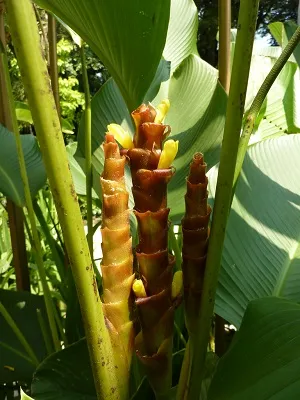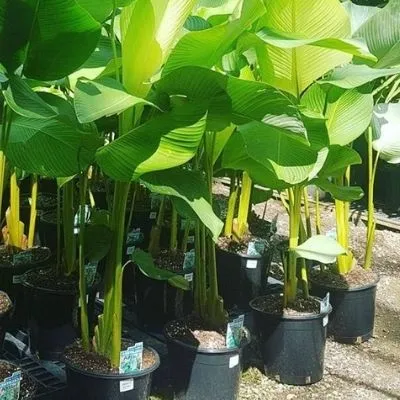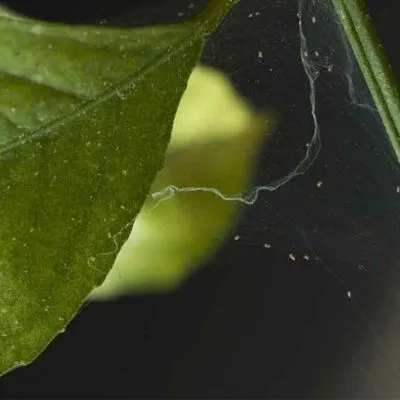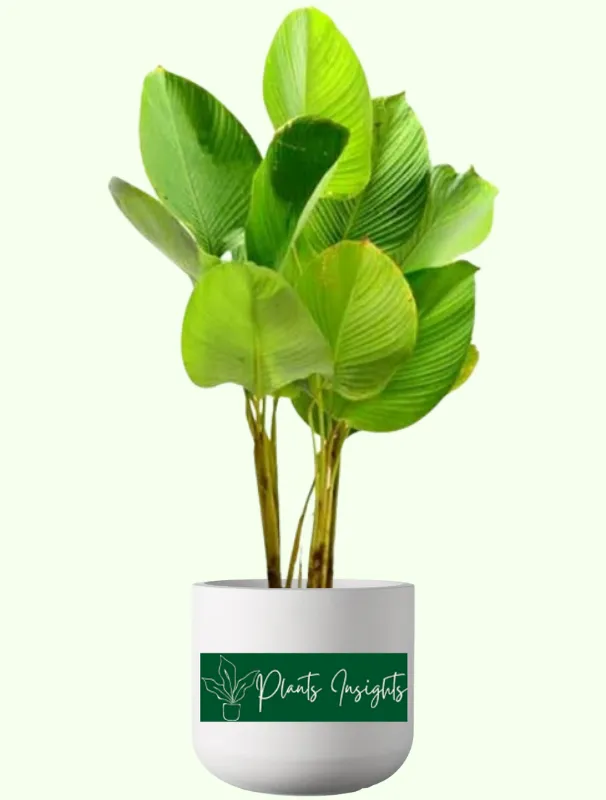Calathea Lutea is a unique plant in the Calathea family with large dark green, paddle-shaped leaves. The plant is different from low-laying family members as it grows pretty tall, around ten to twelve feet. The paddle-shaped leaves extending from individual stem makes the plant a perfect choice to beautify your garden corners. Calathea Lutea is also famous for the Havana Cigar plant and Cigar Calathea because of the cigar-like flowers.
Calathea Lutea can be grown indoors and outdoors; however, it is an ideal choice for outdoors due to the size and the plant’s ability to tolerate partial sun. You can plant Calathea Lutea outdoors as a screening plant or brighten your balcony with large decorative leaves.
Prominent Family Members: Calathea Vittata, Calathea Leopardina, Calathea Crocata, Calathea Rufibarba, Calathea Ornata, Calathea Orbifolia, Calathea Warscewiczii
Essential Products:
How do you care for Calathea Lutea?
Calathea Lutea is a humidity-loving plant that thrives well in partial sun or filtered light. The plant prefers warmer temperatures and requires moist soil for rapid growth. It is an easy-going Calathea that can flourish outdoors and indoors and grow up to thirteen feet tall. Please keep reading our care guide to keep your Calathea Lutea happily growing in your garden.

Early days of Calathea Lutea in your home

I adore the paddle-shaped leaves of this plant, and any plant lover would like to add the Calathea Lutea to their collection. However, whenever you bring a new plant to your home, it shall pass through a close inspection and quarantine policy.
The leaves of Calathea Lutea are pretty large and can be home to spider mites, aphids, or mealy bugs. Therefore, examine the plant closely for any underlying disease and, if found, treat the anomaly following our recommendations from the diseases section.
In any case, the new plant shall be kept apart from your existing houseplants for at least two weeks to prevent infestation spread. Once the isolation period is over and you do not observe any irregularity, move the Calathea Lutea to its permanent setting.

Does Calathea Lutea have any Specific Light Requirements?
Calathea Lutea is one of the Calathea species that grows up to thirteen feet in the natural environment with huge leaves that require more light than other Calathea plants. You can place them indoors, but you shall select a place that has bright sunlight.
Moreover, they need a light source that distributes light evenly to all plant leaves; otherwise, plant growth will be uneven and at strange angles. Windows from the ceiling is a good option; otherwise, provide an artificial bright light above the plant.
Due to the larger size, it is recommended to plant the Calathea Lutea outdoors in the garden. Calathea Lutea cannot withstand the sunlight for the whole day; therefore, you shall select a place for the plant that gets soft morning light and is protected from afternoon strong sunlight.
Nature has designed plant leaves waxy and whitish from the underside to protect them from heat. At the same time, the upper side is green to absorb maximum light for photosynthesis.

Humidity and Temperature for Calathea Lutea
Lutea plant is native to a tropical land and likes to live in temperature ranges from 65-80°F. You shall try to mimic the native environment of the plant to achieve maximum growth. The plant in its natural habitat blooms every season, while in other zones, it usually blossoms from early spring to late summer.
Leaves of the plant will start curling if the temperature is not according to the plant’s requirement. The minimum temperature at which the plant can survive is 60°F; therefore, if you live in a region where the temperature drops from 60°F in winter, you shall bring the plant indoors during the cold season.
The plant will grow well in the humidity range of 50% or more with the ideal humidity level of 70%. If you are growing Calathea Lutea indoors, the best way to provide the required humidity to plant is by using a humidifier. Keep monitoring the humidity levels with a hygrometer as less humidity will cause leaves of the plant to become dark in color and fall.
Misting is another way to increase moisture around the plant leaves. It will keep the plant hydrated for a short duration; however, ensure to remove water from leaves by wiping to avoid the development of fungal diseases.

How often do you water Calathea Lutea?
In the growing season, Calathea Lutea requires regular watering. It starts from spring to late summer, and two times a week, watering will be enough to keep the soil moist round-the-clock. Don’t let Calathea soil dry as it will affect plant growth by wilting leaves and browning edges.
Overwatering will lead to root rot; therefore, continue monitoring the soil moisture levels. Please ensure to reduce the water intake during winter as the evaporation rate decreases and the plant requires less water in the dormancy phase. Water the Calathea Lutea only when the topsoil has become dry. Use the soil moisture meter to check soil moisture level and accordingly water the plant.
We suggest not using tap water as it contains fluoride and chlorides, and Calathea Lutea is sensitive to these chemicals. Rainwater is the best option for optimum growth, but you may use distilled water, or filtered water rainwater is unavailable.

Cigar Plant Soil Requirements
Tropical rainforest soil is rich in organic matter, and the ideal soil for the Cigar plants shall contain all the constituents present in tropical soil. You shall select the soil rich in organic matter and has the quality to retain a certain amount of moisture for an extended period so the roots can get organic nutrients from the soil.
Soil richness and drainage quality matter greatly for Calathea Lutea’s maximum growth. Readymade soils are available in the market and are rich in nutrients and with the best drainage qualities. However, if you want to make a soil mix for the Havana plant, use three parts of the potting soil, one part of charcoal, orchard bark, and lastly, perlite for best drainage.

Calathea Cigar Plant Pruning
Calathea Lutea grows richly and lavishly with delicate thin stalks displaying beautiful large foliage. Due to the size, a single yellowing or damaged leaf will be dominantly visible among the cluster of leaves. Calathea Lutea does not require pruning other than removing such diseased leaves. Always use a sterilized sharp knife or scissors to cut off the plant’s damaged, dead, or overgrowth parts.

Fertilizing Lutea Plant
Calathea Lutea needs more nutrition in the growing season. To boost the growth, fertile the Lutea plant once a month with a dilute mixture. Be cautious that excess fertilization can burn your plant due to salt accumulation in the soil.
Don’t fertizle the plant in winter as plant growth is slow compared to summer. Use a fertilizer with nitrogen, potassium, and phosphorous in an equal amount. Don’t forget to water your plant and make sure the first three inches of the potting soil are wet before fertilizing.
Healthy plant after fertilization
You shall notice salts accumulation in the soil, as the excessive salts can make the upper crust of soil hard, making it difficult for water to pass through it. In such a case, break the soil crust with a sharp tool and flush away the excess salts from the soil by a thorough watering.

Repotting Cigar Plant
Calathea Lutea has a fast growth rate, and usually, in one to two years, the roots outgrow the container. Your Calathea Lutea will not grow further if the plant is root-bound. Cramped roots in the potting soil also hamper the soil moisture retention and draining qualities. Therefore, it is necessary to shift your Calathea Lutea to a relatively bigger container to provide extra room for roots to grow.
Repotting is not a tricky task; however, due to the large size of Calathea Lutea requires a bit of effort. To repot your Calathea Lutea, water the plant thoroughly a day or two before repotting. It is always easier to take the roots out of the container without damaging them if the soil is moist. Before removing the plant from the existing container, prepare the new soil mix and fill the new container up to one-third level.
Remove the Calathea Lutea carefully from the pot without damaging the roots. Place the plant in the new container and fill it with the prepared soil mix. Water the plant deeply and remove extra water from the container tray.

How do you separate Calathea Lutea?
The propagation success rate for most Calathea family plants through seeds or cuttings is meager. Like its family members, Calathea Freddie and Makoyana, the Lutea plant is best propagated via division of roots. The best time to propagate this plant is in spring before the growing season, and we recommend carrying out propagation when you are going to repot the plant.

Propagation
Here are a few steps which will help you to propagate easily.
Now, wait for new growth on the baby plant before shifting it to a permanent location.

Is Calathea Lutea toxic to dogs and other pets?
Calathea Lutea is an entirely safe plant for your dog, cats, and any other pet. The plant is non-toxic to humans also. You can well imagine the harmless nature of the plant by the fact that its leaves are used as food wrappings in Panama. Therefore, do not worry if your pet or kid accidentally ingests the leave.

Pests, Diseases, Common Problems and Queries
Spider mites, mealybugs, fungal gnats, and scales are the pests that you might find on Calathea Lutea. These pests are plant sapsuckers that damage the leaf by making colonies underside the broadleaf.

Spider mites web on leaf and stem
Spider mites can easily be recognized by the web on leaves and stems. Remove the colonies manually by wiping with a damp cloth and use Neem oil on the leaves to prevent recurrences. If pests attack is severe, you may apply the pesticides and prune the infected leaves.
Fungal gnats are attracted by wet soil. If you notice the development of fungal gnats, use the sticky traps to control the problem. As fungal gnats love the moist soil, dress a layer of sand on top of your soil mix to deprive gnats of the moisture. If the problem persists, shift the plant to a new soil mix and stop over-watering.
If the Lutea plant suddenly starts losing its strength and freshness, check the soil and cracks because the mealybugs creep into the crevices and attack the roots. It’s necessary to provide the plant with relief from the situation immediately. Neem oil is an effective treatment for mealybugs, or you can use a pesticide also.
Why are Calathea Lutea leaves yellowing?
The yellowing of the leaves in Calathea Lutea can be because of overwatering and less light exposure to plants. Please reevaluate the climatic conditions of the plant and provide a solution accordingly.
Can Calathea Lutea survive indoors?
Calathea Lutea can be planted indoors; however, review your indoor space beforehand as Calathea Lutea can grow up to the height of thirteen feet when grown indoors. Additionally, the plant requires bright light with even distribution for all leaves. Therefore, placing the plant under a ceiling window will be ideal for the plant, or you may install an artificial light on top of the plant.
How fast does Calathea Lutea grow?
Calathea Lutea is a rapidly growing plant. If you provide optimum growing conditions of moist nutrient-rich soil, partial sunlight, and high humidity, the plant can grow up to 10 feet in merely one year.


